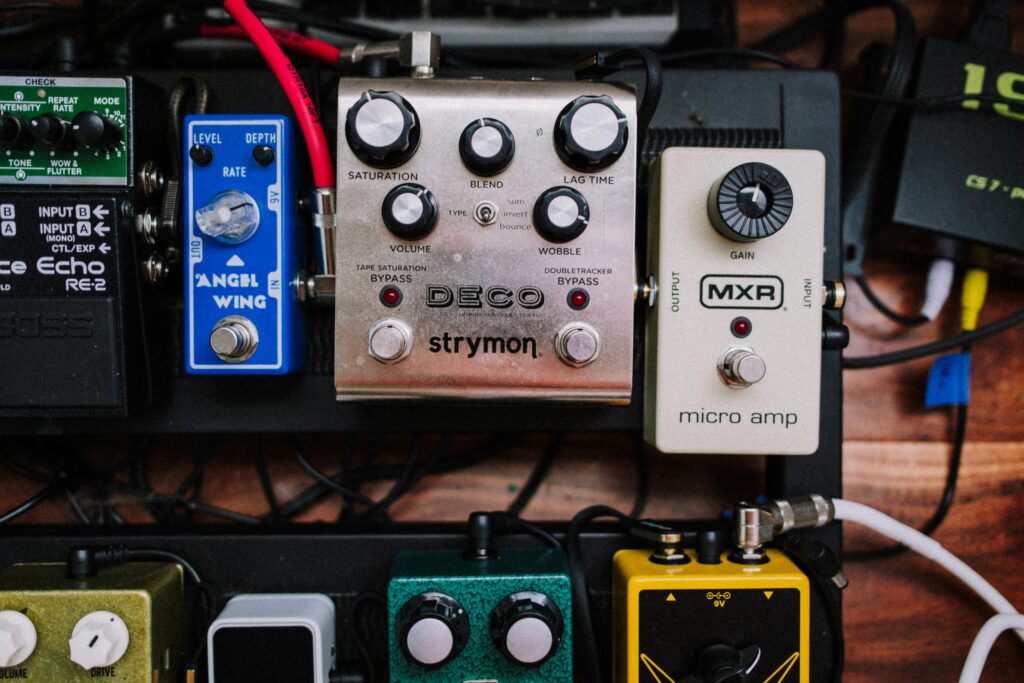
From heavily distorted metal solos to room-filling, chorus-drenched chord progressions, the history and evolution of guitar effects pedals have had a huge impact on creating the most popular sounds of the last 60 years. If you’re a music fan, chances are you’ve heard an almost endless variety of guitar tones over the years, all of which are only possible with the help of guitar effects pedals.
Guitar pedal history is largely a story of technological advancements and experimentation that continues to this day. Understanding a bit more about this story can go a long way in helping you comprehend how popular music has evolved and how you can refine your own tone to create the sounds of the future.
While musicians had been experimenting with electric guitars since the early 1930s, the first effects pedals began to emerge on the scene in the 1960s. The Maestro Fuzz Tone, released in 1962, is largely considered the first mass-produced guitar pedal, with the Dallas-Arbiter Fuzz Face quickly following.
Many popular musicians of the late 1960s psychedelic movement heavily incorporated this tone into their sound. Jimi Hendrix, The Beatles, The Rolling Stones, and many more all used fuzz pedals in some form or another, with songs like Voodoo Child, Helter Skelter, (I Can’t Get No) Satisfaction, and Iron Butterfly’s In-A-Gadda-Da-Vida, are early examples of popular musicians implementing fuzz pedals into their guitar tone arsenal.
In addition to fuzz pedals, Vox also released the first Wah-Wah pedal in 1967, which guitar virtuosos like Jimi Hendrix, Jimmy Page, and Eric Clapton quickly picked up and made famous.
The 1970s witnessed a significant surge in pedal production, with household names like Boss, MXR, and Electro-Harmonix all entering the guitar pedal market for the first time. Electro-Harmonix released their legendary Big Muff Pi fuzz pedal, and MXR released the Phase 90, which was a phaser pedal that created completely new, jet-like textures. Boss also crafted the CE-1, which is the first chorus pedal to ever exist. This added even more tonal variety to the arsenal of the guitar legends of this age.
Standardization was another significant product of the 1970s, with guitar pedals beginning to come in more uniform sizes and layouts, and the 9-volt power standard becoming the norm. This meant that guitarists could start chaining multiple pedals together, allowing them to further experiment with crafting new sounds, while also creating the need for the first pedalboards.
Before the 80s, everything was analog, but with the advent of the digital age, that all changed. Digital effects, especially digital delays, reverbs, and pitch-shifters, became incredibly popular among musicians during this time, as they experimented with these new, futuristic tools.
While many modern purists now swear by analog pedals, these new digital pedals were a groundbreaking innovation that musicians simply couldn’t ignore. They promised to bring increased precision and tonal complexity to live shows, while also encouraging the use of the many lush, clean tones that defined much of the popular music of the 1980s.

The 1990s saw the advent of grunge bands like Nirvana, which marked a significant return to raw, gritty, and fuzzy tones. Noise rock also gained popularity with bands like Sonic Youth, who used a multitude of different types of pedals simultaneously, while also incorporating more unconventional, DIY sounds. Shoegaze, which got its name from the way its guitar and bass players would stare down at the myriad of pedals at their feet, also brought giant pedalboards and new effects combinations into the mainstream.
The sounds of the ’90s were largely a rebellion against the overproduced recordings from the decade before. However, the emergence of smaller boutique guitar pedal companies, such as Fulltone, ZVex, and Keely Electronics, all had a hand in creating more unique and niche pedals that helped many of the decade’s most popular musicians create the new tones they became known for.
By the turn of the century, guitar players had an almost endless variety of tools and effects pedals to experiment with. Not only did guitar players start combining analog and digital effects on the same pedalboard, but multi-effects processors also added even more options for guitar players to experiment with.
Larger pedals like Line 6’s DL4, Strymon’s Timeline, and Eventide’s TimeFactor also became more popular, introducing huge jumps in tonal quality and customization as well as higher power draws that required guitarists to get more creative with their rigs.
Nowadays, we’ve arrived at the culmination of guitar pedal history and are living in a golden age of guitar effect experimentation, New mass-produced and boutique pedals are hitting the market every day and with so many options to choose from, this focus on variety of pushing boundaries has put a lot more pressure on guitar players to create the ideal custom pedalboard to meet their specific needs, but that’s where Pedal Pad comes in.
Here at Pedal Pad, we specialize in handcrafting high-quality custom pedalboards that make it easy for guitar players to elevate their sound, experiment with new tonal possibilities, and streamline the process of setting up and tearing down their guitar rigs.
While mass-produced boards utilize cheap metals and limit customization options, we take the opposite approach. We craft our boards from the highest-quality Baltic Birch Wood, featuring durable built-in cases that keep your gear safe, as well as a wide variety of sizes, colors, and finishes to choose from. We also offer more niche customization options, such as built-in audio inputs and outputs, power switches, and inlets and outlets, among others.

Are you ready to upgrade your guitar rig? Call us or reach out through our website. Creating custom pedalboards is our passion, and if you have an idea, we’re confident we can make your vision come true. Don’t settle for a boring, mass-produced board when you don’t have to. Contact Pedal Pad and start designing your perfect custom pedalboard today!